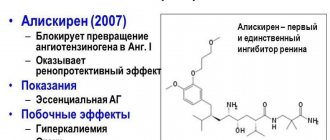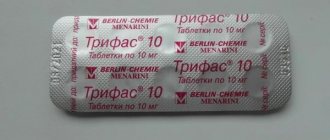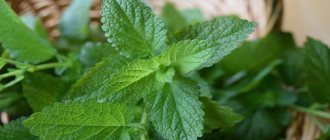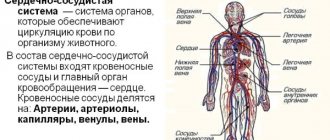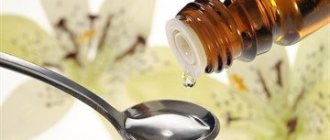Pharmacodynamics and pharmacokinetics
Pharmacodynamics
The drug belongs to dihydropyridine and is part of the group of “slow” calcium channel blockers. Affects the process of calcium entry into smooth muscle cells of peripheral and coronary arteries; suppresses the process of release of calcium ions from depots inside cells. The drug reduces the number of functioning channels, but does not affect the time and speed of their activation and restoration. It influences the processes of contraction and excitation of myocardial muscles and vascular smooth muscles.
In therapeutic doses, it normalizes the disturbed transmembrane current of calcium ions that forms during arterial hypertension . Increases blood flow in the heart muscle, does not affect venous tone, normalizes the functioning of collaterals, improves blood supply to ischemic heart muscle, reduces myocardial tone and peripheral vascular resistance, as well as the need for oxygen in the heart muscle, afterload. Causes moderate natriuresis , improves renal blood flow, has virtually no effect on heart rate, atrioventricular and sinoauricular nodes.
Pharmacokinetics
The drug is almost completely absorbed from the gastrointestinal tract . Bioavailability is 40 - 70%. High connection with blood proteins ( albumin ). Metabolized intensively in the liver (40-60%) to pharmacologically inactive metabolites. Cmax when taking 10 mg of the drug orally is achieved after one hour. The half-life is about four hours. Penetrates through the BBB .
Excreted by the kidneys and through the intestines.
Composition and properties of tablets
The drug Cordafen is available in tablet form. They have a round, biconvex shape and are yellow in color.
The active substance of the tablets is nifedipine, of which one tablet contains 10 mg. Among the excipients are:
- gelatin;
- microcrystalline cellulose;
- talc;
- magnesium stearate;
- lactose;
- potato starch.
The tablets have a film coating, which consists of macrogol 6000, titanium dioxide, propylene glycol, hypromellose, quinoline yellow varnish E-104, talc.
Nifedipine enters the bloodstream from the digestive tract and is absorbed by approximately 90%. The maximum therapeutic effect is achieved from half an hour to two.
Cordafen is quickly and almost completely converted in the liver into inactive metabolites. The half-life of the drug is 2-5 hours. 80% is excreted by the kidneys in the form of metabolites, about 20% with bile.
The elimination time of the medication in question increases if a person has problems with the kidneys and/or liver.
Contraindications
High sensitivity to the drug, aortic stenosis , unstable angina , collapse , age under 18 years, myocardial infarction , CHF , first trimester of pregnancy , cardiogenic shock , lactose intolerance, lactation, arterial hypotension .
Use with caution in patients with mitral valve stenosis , sinus node weakness, bradycardia , cerebrovascular accidents, liver/kidney diseases, hemodialysis , and over the age of 60 years.
Cordafen instructions for use
Self-medication can be harmful to your health. You should consult your doctor and read the instructions before use.
Active ingredient: Nifedipine 10 mg
Excipients: potato starch, lactose, microcrystalline cellulose, gelatin, talc, magnesium stearate.
Shell: hypromellose, macrogol 6000, quinoline yellow varnish (E104), propylene glycol, titanium dioxide, talc.
Description
Film-coated tablets, round, biconvex, yellow.
pharmachologic effect
Pharmacokinetics
Indications for use
Contraindications
• Hypersensitivity to nifedipine
• Severe heart failure
• Severe hypotension (systolic blood pressure below 90 mmHg)
• Cardiogenic shock
• Severe aortic stenosis
• 1-4 weeks after myocardial infarction
• Unstable angina and severe angina attacks
• Pregnancy and breastfeeding
• Children and adolescents under 18 years of age (no evidence of safety)
Pregnancy and lactation
There is no information regarding the use of nifedipine in pregnant women. Cordafen is contraindicated during pregnancy.
Nifedipine passes into mother's milk. When using the drug, breastfeeding should be interrupted.
Directions for use and doses
Cordafen tablets are intended for oral administration.
For conditions requiring immediate intervention, the following is usually used:
Adults: initially 10 mg 3 times daily,
If necessary, the dose can be increased to 20 mg 3 times a day under the control of blood pressure. The maximum daily dose is 60 mg.
The drug can be taken regardless of meals. The tablets should be swallowed whole with a small amount of liquid.
Side effect
After using nifedipine, the following undesirable symptoms appeared (clinically confirmed): dizziness, facial flushing, feeling of heat, headache, weakness, nausea, muscle cramps, trembling, swelling in the periphery, nervousness, mood changes, palpitations, suffocation, cough, hyperemia of the mucous membranes nose, pharyngitis, temporary hypotension.
Overdose
Interaction with other drugs
- Nifedipine may limit the ability to drive vehicles and maintain mechanical equipment.
- Nifedipine may increase the symptoms of coronary heart disease and cause acute myocardial infarction, especially in patients starting treatment with the drug or increasing the dose of the drug.
- In patients treated with beta-blockers, treatment with these drugs should not be suddenly interrupted (before starting nifedipine therapy) due to the possibility of increased symptoms of coronary insufficiency.
- Nifedipine should be used cautiously in patients with heart failure or narrowing of the aorta, especially those treated with beta-blockers, as nifedipine may accelerate the onset or worsen the course of existing heart failure.
- Nifedipine, by reducing peripheral resistance, can cause significant hypotension that is poorly tolerated by patients.
- Nifedipine in immediate release form should not be used in the long-term treatment of hypertension and other diseases requiring the use of the drug in a dose exceeding 60 mg per day.
- With prolonged use, tolerance and withdrawal syndrome may develop.
Release form
The drug Cordafen 10 mg is packaged in 50 tablets in blisters (2 blisters of 25 tablets each) made of A1/PVC foil, which are placed together with instructions for use in a lithographed box with label text and a barcode.
Storage conditions
Store in a place protected from moisture and light, at a temperature below 25°C.
Keep out of the reach of children.
Do not use the drug after the expiration date.
Best before date
3 years
Conditions for dispensing from pharmacies
3 years
Cordafen analogues, synonyms and group drugs
- Nifecard xl
- Cordipin retard
- Cordipin
- Nifedipine
- Phenigidine
- Phenigidine-health
Self-medication can be harmful to your health. You should consult your doctor and read the instructions before use.
Source: https://apteka.103.by/kordafen-instruktsiya/
Side effects
blood pressure , development of heart failure, arrhythmia , facial skin flushing, peripheral edema , feeling of heat, tachycardia , pain, palpitations dizziness , weakness, fatigue, headache , drowsiness , anxiety, increased appetite, gum hyperplasia , dyspepsia , dryness in the mouth, agranulocytosis , anemia , allergic reactions, arthritis , myalgia , arthralgia , increased daily diuresis , weight gain.
Contact effects with other medications
The drug can act on other medications. In some cases, it changes its effect under the influence of other drugs. This is always taken into account during admission. This is why it is so important to tell your doctor about all the medications you are currently taking or have recently taken.
What combinations need to be considered:
- Cordafen + a medicine with vincristine can inhibit the removal of the latter component from the body, and also accentuate its negative effects.
- Lithium medications, if taken together with Cordafen, may increase the risk of toxic effects. So, the patient may experience indigestion, nausea and vomiting.
- Medications with a high binding factor, for example, indirect anticoagulants, quinine, and anticonvulsants, have a similar effect in combination with Cordafen - they are forced out of their binding to proteins. Further, their level in the blood plasma will only increase.
- Quinidine and procainamide, in addition, their analogues can provoke prolongation of the QT interval to dangerous values.
- Prazosin and other alpha blockers, together with Cordafen, also do not act in the best way - the metabolism of the main component may be suppressed. That’s why these medications are not prescribed together.
- Please note that simple grapefruit juice can suppress the metabolism of the main component, so it should not be combined with similar medications.
- All antihypertensive medications, if taken in parallel with Cordafen, can enhance the effect of lowering blood pressure.
- Blockers of so-called slow calcium channels can optimize the inotropic negative effect of antiarrhythmic drugs.
Also, the nifedipine content decreases under the influence of microsomal-type liver fermentation inducers.
Interaction
When taking the drug together with other antihypertensive drugs, nitrates , tricyclic antidepressants and inhalational anesthetics, the severity of the decrease in blood pressure increases. Nifedipine reduces the concentration of quinidine and increases the concentration of digoxin and theophylline in the blood.
Taking the drug in combination with nitrates leads to increased tachycardia . Nifedipine inhibits the metabolism of alpha-blockers , which leads to increased hypotensive effects. Nifedipine vincristine from the body , which increases its side effects. The hypotensive effect of the drug is reduced by NSAIDs , sympathomimetics, and estrogens . Calcium supplements weaken the effect of nifedipine .
Treatment regimens
These tablets are taken orally. The medicine should be swallowed whole, without chewing, and washed down with a small amount of water.
Meals do not affect the drug dosage regimen in any way. Cordafen can be taken before or after meals, or between meals.
The initial dose is 10 mg, although the doctor considers each individual case on an individual basis. You should take the tablets three times a day.
If such a need arises, the dose of Cordafen is increased to 20 mg. But in this case, the drug should be taken only 2 times a day, while not forgetting to monitor changes in blood pressure.
The amount of medication taken should be reduced in the following cases:
- the patient is in the older age category;
- liver functions are impaired;
- the patient has a severe cerebrovascular accident;
- taking antihypertensive or antianginal pharmaceuticals.
The maximum daily dose of Cordafen is 40 mg. If you exceed it, you can provoke extremely undesirable consequences for the body.
overdose can be determined by the following signs:
- hyperemia of the skin on the face;
- suppression of sinus node function;
- bradyarrhythmia;
- headache;
- long-term decrease in blood pressure;
- bradycardia.
If you notice the above symptoms, seek medical attention immediately. Specialists will perform gastric lavage and select medications to eliminate the consequences of an overdose of Cordafen.
If you require a large dose for treatment, it is better to take the drug in long-acting dosage forms.
Cordafen's analogs
Level 4 ATC code matches:
Lacipil
Azomex
Nimodipine
Felodipin
Nifedipin-gel
Farmadipin
Amlotop
Nimotop
Tenox
Nifecard HL
Cordipin
Felodip
Normodipine
Phenigidine
Norvask
Cordaflex
Lerkamen
Corinfar
Vero-Amlodipine
Amlodipine
Preparations with similar active ingredients include: Adalat , Anifed , Vero-Nifedipine , Cordaflex , Hypernal , Zenusin , Depin-E , Calcigard , Corinfar , Nicardia , Cordipine , Nifebene , Nifehexal , Nifedicor , Nifedex , Nifedipine , Myogard , Nifecard , Nifesan , Ronian , Fenamon , Sanfidipin , Fenigidin , Ecodipin and others.
Pharmacokinetic profile
Almost completely, at least 90%, nifedipine is absorbed in the digestive tract. The bioavailability of the pharmaceutical drug lies in the range of 40-70%. Primary hepatic passage is marked by significant metabolism of 40-60% of the administered dosage. The maximum concentration of the active component in the plasma part of the blood after oral administration will occur in 30-60 minutes (based on a dosage of 10 mg). The half-life is 2-4 hours.
With proteins of the plasma part of the blood, i.e. albumin, the substance binds within 97%. Nifedipine has the ability to cross the placental barrier and is also excreted into breast milk. The drug is almost always metabolized into three metabolites that do not differ in pharmacoactivity. Approximately 60-80% of the drug is excreted through the kidneys through urine, the rest is excreted through the bile excretion pathway.

